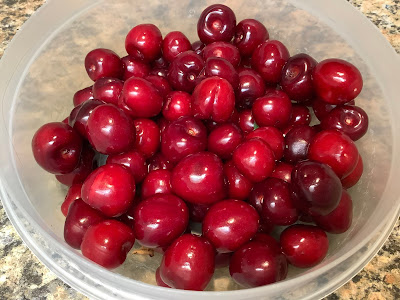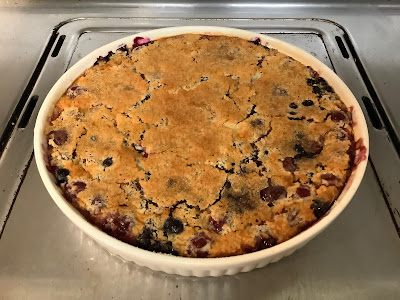
Recipe: Cherry-blueberry clafoutis, served warm or cold
 |
|
It's cherry season, and these beauties are
destined for a clafoutis. (Photos: Debbie Arrington)
|
This is cherry season, a fleeting late-spring delight. For home growers, every little fruit seems like a miracle – or a challenge. So many things – wind, rain, birds, squirrels – can destroy a once-promising crop. But for the lucky grower with a full tree, a bounty of cherries also produces a mountain of pits.
Blueberries are ripening now, too. This month, my little blueberry bushes are finally producing enough berries to actually MAKE something and not just nibble in the garden. But one cup at a time is not enough to make a full fruity dessert with just blueberries.
Thanks to a neighbor’s generosity, I had a pint of fresh-picked homegrown cherries, as bright and beautiful as rubies, to go with my cup of blueberries. Together, they were just enough fruit for this combination clafoutis.
A clafoutis (pronounced klah-foo-tee) is a French fruity flan-like dessert. Tradition dictates that it be made with cherries, preferably black. Any other fruit, this dessert becomes a flaugnarde, according to my French cookbooks.
But that’s in France. American cooks (myself included) adapt this dessert to what’s in season – including blueberries, apricots, pears and apples. And we call it a clafoutis or clafouti (with no “s”). Either way, it’s delicious.
Another plus: This versatile dessert can be served warm or cold, making it a perfect summer treat. (It’s also tasty for breakfast or brunch.)
Instead of a traditional post-baking dusting of powdered sugar, a little Demerara sugar before baking adds crunch to the top of this clafoutis.
 |
|
The clafoutis is topped with Demerara
sugar for a nice crunch.
|
Cherry-blueberry clafoutis
Makes 8 servings
Ingredients:
Butter and sugar to grease and dust pan
2 cups cherries, pitted
1 cup blueberries
1 tablespoon sugar
3 eggs
½ cup sugar
½ cup flour
¾ cup heavy cream
¾ cup milk
1 teaspoon vanilla extract
2 tablespoons Demerara sugar
Whipped cream, optional
Instructions:
Preheat oven to 350 degrees F.
Prepare an 11-inch tart or quiche pan or 10-inch deep pie plate. Grease pan with butter. Sprinkle with sugar, then invert to remove excess. Set aside.
 |
|
The whipped cream topping is optional for serving but
delicious.
|
In a large bowl, gently toss cherries, blueberries and 1 tablespoon sugar. Set aside.
In a mixing bowl, beat eggs with an electric mixer until foamy. Add ½ cup sugar and beat until foamy and fairly thick. Add the flour and beat until smooth. Then, add cream, milk and vanilla; beat until mixture is smooth and thick.
Arrange the fruit in a single layer at the bottom of the prepared baking dish. Pour batter over fruit. Sprinkle with Demerara sugar over top.
Bake at 350 degrees until top is nicely browned and custard is set; a thin knife blade inserted near center will come out clean (about 30 minutes).
Serve warm or cold, with whipped cream if desired. Refrigerate leftovers.
Comments
0 comments have been posted.Sacramento Digs Gardening to your inbox.
Food in My Back Yard Series
May 6: Maintain soil moisture with mulch for garden success
April 29: What's (already) wrong with my tomato plants?
April 22: Should you stock up on fertilizer? (Yes!)
April 15: Grow culinary herbs in containers
April 8: When to plant summer vegetables
April 1: Don't be fooled by these garden myths
March 25: Fertilizer tips: How to 'feed' your vegetables for healthy growth
March 18: Time to give vegetable seedlings some more space
March 11: Ways to win the fight against weeds
March 4: Potatoes from the garden
Feb. 25: Plant a fruit tree now -- for later
Feb. 18: How to squeeze more food into less space
Feb. 11: When to plant? Consider staggering your transplants
Feb. 4: Starting in seed starting
Sites We Like
Garden Checklist for week of May 4
Enjoy this spring weather – and get gardening!
* Plant, plant, plant! It’s prime planting season in the Sacramento area. Time to set out those tomato transplants along with peppers and eggplants. Pinch off any flowers on new transplants to make them concentrate on establishing roots instead of setting premature fruit.
* Direct-seed melons, cucumbers, summer squash, corn, radishes, pumpkins and annual herbs such as basil.
* Harvest cabbage, lettuce, peas and green onions.
* In the flower garden, direct-seed sunflowers, cosmos, salvia, zinnias, marigolds, celosia and asters. (You also can transplant seedlings for many of the same flowers.)
* Plant dahlia tubers. Other perennials to set out include verbena, coreopsis, coneflower and astilbe.
* Transplant petunias, marigolds and perennial flowers such as astilbe, columbine, coneflowers, coreopsis, dahlias, rudbeckia and verbena.
* Keep an eye out for slugs, snails, earwigs and aphids that want to dine on tender new growth.
* Feed summer bloomers with a balanced fertilizer.
* For continued bloom, cut off spent flowers on roses as well as other flowering plants.
* Add mulch to the garden to maintain moisture. Mulch also cuts down on weeds. But don’t let it mound around the stems or trunks of trees or shrubs. Leave about a 6-inch to 1-foot circle to avoid crown rot or other problems.